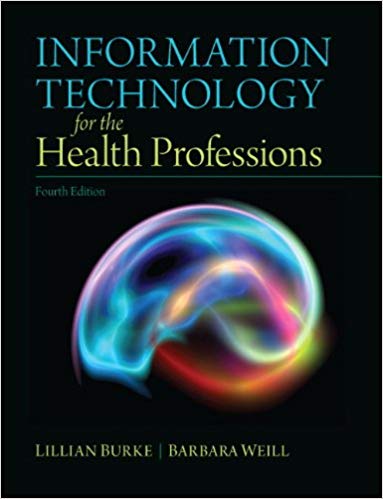Description
Information Technology for the Health Professions 4th Edition By Lillian Burke – Test Bank
Chapter One Exam
Multiple Choice Choose the one alternative that best completes the statement or answers the question.
1. Information technology includes the use of computers, communications ______________, and computer literacy.
A. groups
B. tags
C. networks
D. None of the above
2. An electronic device that can accept data as input, process it according to a program, store it, and produce information as output is called a/an _________________.
A. calculator
B. adding machine
C. multiplication table
D. computer
3. Step-by-step instructions are called a _________________.
A. menu
B. program
C. hardware
D. None of the above
4. A _______ is a computer contained in a touch screen.
A. supercomputer
B. tablet
C. mainframe
D. None of the above
5. A tiny ____________ can be put into a human being and can dispense medication among other things.
A. supercomputer
B. personal digital assistant (PDA)
C. embedded computer
D. minicomputer
6. ________________ take data that humans understand and digitize it, that is, translate it into binary form of ones and zeroes.
A. Output devices
B. Input devices
C. Storage devices
D. None of the above
7. A/An _________________ manipulates data, doing arithmetic or logical operations on it.
A. output device
B. input device
C. storage device
D. processing unit
8. _____________________ can take complex mathematical data and create simulations of epidemics, pandemics, and other disasters.
A. Supercomputers
B. Personal digital assistants (PDAs)
C. Embedded computers
D. Minicomputers
9. __________________ are used in business for input/output intensive purposes, such as generating pay checks or processing medical insurance claims.
A. Supercomputers
B. Personal digital assistants (PDAs)
C. Mainframes
D. None of the above
10. _______________________ identifies people by their body parts. It includes fingerprints, handprints, face recognition, and iris scans.
A. Biometrics
B. All security systems
C. Both A and B
D. None of the above
Chapter One Exam
Fill-Ins Write the word or phrase that best completes each statement or answers the question.
1. The term _______________ includes knowledge of computers, the Internet, and computer literacy.
2. A computer manipulates data by following step-by-step instructions called a _______________.
3. _______________ are the largest and most powerful computers at any time. They are used for weather forecasting and scientific research.
4. _______________ devices take data that humans understand and input it into the computer in digital form of ons and offs, ones and zeroes that the computer can process.
5. _______________ are the second largest computers at any time. They are used for input/output intensive operations like generating payroll.
6. ___________ computing refers to “the act of utilizing a network, usually the Internet, to store information that you want to access from multiple network devices.” The technology allows the user to access all information via the Internet.
7. The embedded computer is a single-purpose computer on a _______________ of silicon.
8. In a digital computer, all information including text, music, animation, graphics, smell, and sound is represented by combinations of ones and zeroes, called _______________ or bits.
9. The physical components of a computer are called _______________.
10. _______________ is changeable, temporary, volatile memory.
11. _______________ or firmware contains basic start-up instructions, which are burned into a chip at the factory; you cannot change the contents.
12. _______________ refers to the programs—the step-by-step instructions that tell the hardware what to do.
13. The _______________ is a group of programs that manages and organizes the resources of the computer.
14. _______________ is a wireless technology that can connect digital devices from computers to medical devices to cell phones.
15. Transmission over networks is governed by sets of technical standards or rules called _______________.
Chapter Two Exam
Multiple Choice Choose the one alternative that best completes the statement or answers the question.
1. ________________ refers to the use of computers to organize information in health care.
A. Computer informatics
B. Medical computing
C. Medical informatics
D. None of the above
2. _____________________ uses computers to solve biological problems.
A. Biological informatics
B. Bioinformatics
C. Computerized biology
D. Biological computing
3. _____________________ refers to the connection of people and diverse computer systems.
A. Interoperability
B. Systemic computerization
C. Intersystemology
D. None of the above
4. ________________ is the use of computers and software to enter prescriptions and send them to pharmacies electronically.
A. Computer prescription
B. Elemental prescribing
C. e-prescribing
D. None of the above
5. _____________________ was passed by the U.S. Congress and signed into law in 1996. Its goal was to make health insurance portable from one job to another and to secure the privacy of medical records.
A. HIPAA
B. HIPPA
C. The Americans with Disabilities Act
D. None of the above
6. ________ has the task of overseeing the adoption and meaningful use of EHRs, setting standards, and judging the impact.
A. ARRA
B. The Congress
C. The President
D. ONCHIT
7. The _______________ was signed into law on February 17, 2009, by President Obama; it included billions of dollars for the expansion of health information technology. Through Medicare and Medicaid, monetary incentives would be offered to doctors and hospitals to adopt EHRs.
A. Americans with Disabilities Act
B. USA PATRIOT Act
C. Homeland Security Act
D. American Recovery and Reinvestment Act (ARRA)
8. The federal government has set a goal of the year ___________ for universal adoption of electronic records.
A. 2009
B. 2010
C. 2013
D. 2014
9. Which of the following is TRUE?
A. A fully developed electronic health record sends a warning to doctors of adverse drug reactions.
B. No doctors now use electronic health records.
C. No hospitals now use electronic health records.
D. None of the above
10. Which of the following are obstacles in the way of adopting electronic records?
A. Cost
B. Privacy concerns
C. Lack of interoperability
D. All of the above





Be the first to review “Information Technology for the Health Professions 4th Edition By Lillian Burke – Test Bank”